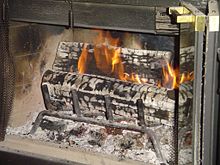Firebuck
A fire Bock , even fire Ross , fire dog or fire buck called, is a mostly two-piece frame in a fire pit, the firewood is placed. The elevated position improves the air supply to the fire and thus ensures better and hotter combustion.
Archaeological finds of different times made of ceramic or iron , which resemble the actual fire rams, but whose function has not been clarified, are also called " fire rams" .
History and Uses
Firebucks were already used in predynastic Egypt .
In the younger Iron Age , iron firebucks appeared; For example, a pair of firebacks were dredged from the Günz gravel near Oberried, which are typical examples of the Latène period (500–15 BC) (now in the Archaeological Museum in Neu-Ulm).
Firebucks were in use throughout the Middle Ages and in modern times , mostly as a frame made of two feet or trestles connected by a chain or crossbar, which was used to lay the wood in front of the fireplace. There are Italian (especially Venetian), French and German firebucks from the Renaissance and other art eras that are decorated with ornaments and figures.
Bronze Age fireborn from Akrotiri , Greece
Ornamental framework
"Firebucks" are also parts of the decorative framework whose shape is reminiscent of a firebuck.
additional
A fire Bock lead the market town Tieschen in Styria and the Büdinger district Büches in their arms.
Web links
Individual evidence
- ↑ M. Baba, M. Saito: Experimental Studies on the firing methods of black-topped pottery in Predynastic Egypt . In: S. Hendrickx (Ed.): Studies in memory of Barbara Adams: Proceedings of the international conference "Origin of the state, predynastic and early Egypt . 2004, p. 587 .










